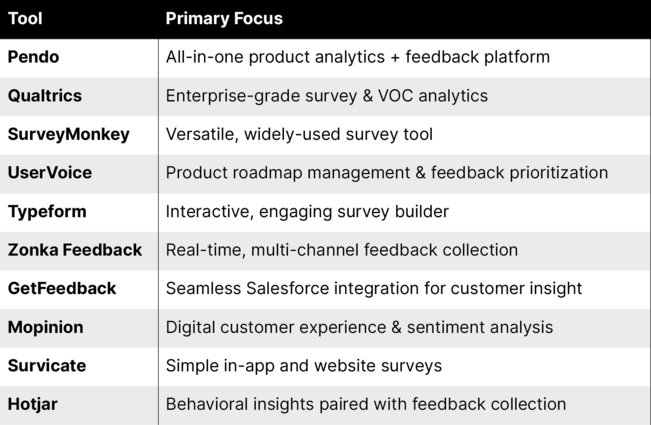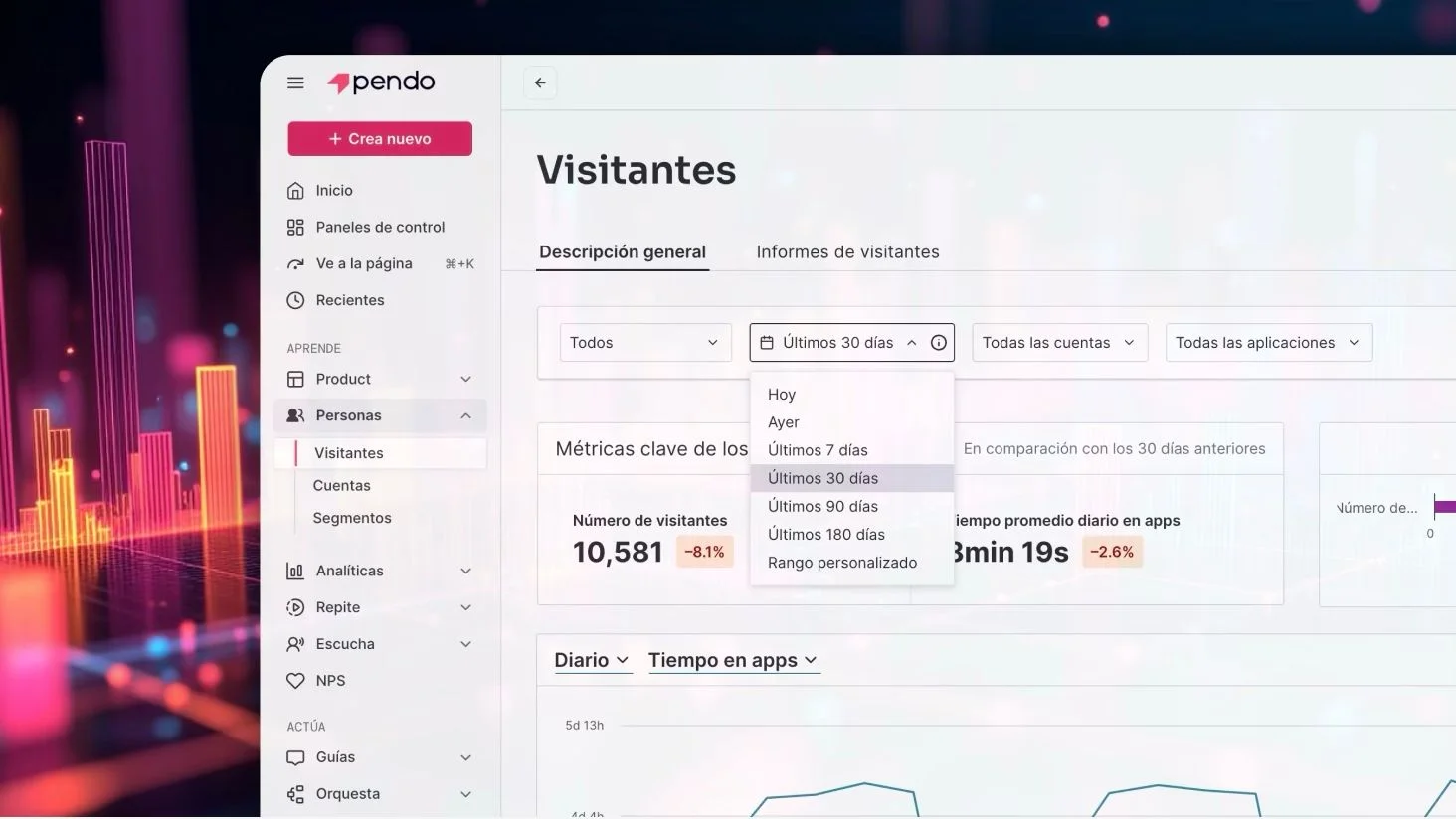Today’s software landscape is dynamic and evolving at pace. That’s why user feedback tools are so crucial. By using these tools effectively, we can really understand what drives user behavior and sentiment, apply rigor to test and improve products, and continue to enhance the overall customer experience.
So what are user feedback tools? And why do they matter?
Fundamentally, these are software applications or platforms that help businesses make sense of complex information that relates to its core users. Think of it as a second, indispensable brain. It can systematically collect, manage, analyze and act on user opinions and experiences. In other words, untangle what real people think and feel about our products.
Rich platforms like these also help product teams to identify bottlenecks early, optimize funnels, and refine the onboarding process. And in turn, strengthen product growth.
What makes a user feedback tool effective?
A great user-feedback tool in 2025 goes beyond just a collection of responses. Instead, it helps teams to take action. The best ones make it easy to build surveys, track NPS, and gather in-app feedback. What then sets top tools apart are smart features like built-in analytics, automation, and Voice of Customer (VOC) insights that transform data into strategic next steps.
The following leading tools stand out due to their ease of use, real-time insights, ability to scale and plug into the rest of your tech stack.
Pendo's unique combination of analytics and feedback features
Pendo stands out by seamlessly integrating powerful product analytics with comprehensive user feedback into one single, unified platform. This approach eliminates "tool sprawl" and fragmented data and instead, provides a clear and consistent source of truth for software experience data.2 In turn, making it easy to track behavior in real-time, gather user feedback, and turn this into meaningful, actionable insights.
By eliminating tool overload and disparate information, Pendo helps teams to work more efficiently and maintain a clear alignment across departments.
A quick glance at the top user feedback tools
Let’s take a look at the market for user feedback tools. Of course, each platform offers distinct strengths to suit different organizational needs. We’ll get into this shortly.
First, a concise summary of the primary focus for the ten leading tools in 2025:

And now a deep dive into the top ten tools
Pendo: The comprehensive product feedback platform
Pendo is the leading Software Experience Management (SXM) platform. It unifies tools to understand, guide, and collect feedback without code , and transforms product teams to be data-driven.
Key features: In-app surveys, deep analytics, product usage tracking, user segmentation, centralized feedback, and integrated Roadmaps.
Best for: SaaS businesses and product-led teams seeking holistic insights, actionable feedback, and unified software experience management for user adoption and growth.
Qualtrics: Advanced feedback and analytics
Qualtrics is a leading experience management platform for customer, employee, product, and brand experiences. It’s known for its comprehensive surveys and advanced analytics.
Key features: Extensive survey options, advanced VOC analytics, and sophisticated sentiment analysis.
Best for: Large enterprises needing deep, sophisticated insights across all experience aspects, handling complex data for strategic decisions.
Comparison to Pendo: Qualtrics excels in comprehensive surveys and VOC analytics for enterprises. But it lacks Pendo's deeply integrated product analytics, which combines user behavior data with customer feedback for a holistic, in-app software experience view.
SurveyMonkey: User-friendly feedback collection
SurveyMonkey is a widely recognized online survey creation tool. It’s known for its accessibility and versatility.
Key features: Template-rich survey creation, robust reporting, advanced survey logic, and branding options.
Best for: Small to mid-sized businesses and for users needing quick, versatile surveys.
Comparison to Pendo: SurveyMonkey is an excellent standalone tool for general survey creation. But it is limited compared to Pendo's deeper product analytics and integrated approach.
UserVoice: Prioritizing product feedback
UserVoice helps product teams manage and prioritize feedback to inform roadmaps, providing a centralized system for collecting, organizing, and acting on customer ideas.
Key features: Idea collection, prioritization, and product roadmap alignment.
Best for: Product teams needing structured feedback management and prioritization, especially large, complex organizations with high feedback volumes.
Comparison to Pendo: UserVoice is highly effective for structured user feedback management and roadmap alignment. But its scope is narrower than Pendo's comprehensive product analytics. Pendo offers a more holistic view by integrating feedback with deep behavioral analytics and in-app guidance.
Typeform: Engaging and interactive surveys
Typeform is known for its visually appealing and conversational approach to surveys and forms. It aims to make data collection a more engaging experience for respondents.
Key features: Conversational surveys, user-friendly design, and extensive integrations. Features conditional logic, multimedia support (images, GIFs, videos), real-time analytics, and mobile optimization.
Best for: Creative or brand-focused companies seeking high engagement in data collection.
Comparison to Pendo: Typeform excels at creating engaging and interactive surveys with a unique conversational style. But it provides less comprehensive analytics compared to Pendo, which combines feedback with deep product usage analytics.
Zonka Feedback: Real-time feedback & alerts
Zonka Feedback is an AI-powered customer experience platform designed to capture and analyze feedback across multiple channels, all in real time.
Key features: Multi-channel surveys, live feedback alerts, and offline capabilities.
Best for: Businesses needing immediate, actionable user feedback across touchpoints. Ideal for CX, marketing, product, and support teams seeking real-time insights and automated workflows.
Comparison to Pendo: Zonka Feedback excels at real-time, multi-channel customer feedback and automated alerts. But in comparison to Pendo, it offers less analytic depth. Pendo’s comprehensive platform integrates feedback with deep product analytics and in-app guidance, offering a more holistic view of the user experience and product performance.
GetFeedback: Integrated Salesforce feedback
GetFeedback is a SurveyMonkey product. It’s designed to integrate seamlessly with Salesforce and provide customer insights directly within the CRM ecosystem.
Key features: Seamless Salesforce integration, customizable surveys, and real-time insights. Supports various survey types (NPS, CSAT, CES) with advanced targeting. Enables embedding feedback across web, app, chat, and offline environments.
Best for: Salesforce-heavy teams needing to fuse customer feedback with CRM data for rapid digital experience iteration and CX program acceleration.
Comparison to Pendo: GetFeedback is an ideal Salesforce add-on and excels integrating customer feedback directly into the CRM. But it lacks the comprehensive standalone product analytics and in-app guidance capabilities of Pendo. Pendo provides a unified platform for understanding user behavior within the product itself. Its scope is broader than GetFeedback's primary focus on CRM-driven customer insights.
Mopinion: Digital customer experience insights
Mopinion is an all-in-one user feedback software. It focuses on helping digital enterprises to gather, analyze, and act upon customer feedback across various digital touchpoints.
Key features: Sentiment analysis, customizable dashboards, and digital feedback management. Create customizable online feedback forms with CX metrics, triggered by user behaviors.
Best for: Digital-focused enterprises seeking detailed sentiment insights and comprehensive digital CX management. Also suitable for budget-conscious businesses collecting customer feedback.
Comparison to Pendo: Mopinion is powerful for digital CX insights and sentiment analysis. But its overall scope is narrower in comparison to Pendo's comprehensive product analytics. Pendo provides a more integrated solution - one that combines feedback with deep product usage data and in-app guidance to deliver a more holistic software experience management.
Survicate: Simple in-app surveys
Survicate is a survey software that makes it easy for businesses to gather ongoing customer feedback through quick in-app and website surveys.
Key features: In-app and website surveys, user targeting, integration-friendly.
Best for: SMBs needing straightforward user feedback tools and product teams validating hypotheses quickly with in-app surveys.
Comparison to Pendo: Survicate is an easy entry-point tool. It’s particularly strong for straightforward in-app and website surveys but is less robust than Pendo's full-featured analytics suite.
Hotjar: Behavioral insights & feedback
Hotjar is a popular tool for understanding user behavior on websites and apps. It combines qualitative feedback with visual insights like heatmaps and session recordings.
Key features: Heatmaps, session recordings, and feedback polls. Provides unlimited heatmaps, daily session recordings, and feedback widgets.
Best for: UX-focused product teams and marketers who need to visualize user behavior and gather direct feedback to optimize website conversion and user experience.
Comparison to Pendo: Hotjar excels at providing behavioral insights through heatmaps and session recordings, offering excellent UX insights. But it provides less comprehensive product analytics compared to Pendo. Pendo's integrated platform combines behavioral data with in-app guidance and robust product analytics. It offers a holistic understanding of the entire software experience lifecycle, whereas Hotjar's primary focus is on visual and feedback data.
What sets Pendo apart
Pendo’s real-time insights, scalability, and unique integration advantage are what set it apart. It offers a fully comprehensive solution for software experience management.
Feedback and analytics all in one place
Pendo's most significant differentiator is its ability to unify product analytics, in-app guidance, feedback, and session replay into a single, cohesive platform. This integrated approach directly addresses "tool sprawl" and fragmented data, providing a vital single source of truth for all software experience data.
What that means is that product teams can simultaneously analyze user behavior, understand feature adoption, deliver targeted in-app messages, and collect contextual feedback - all in one place. It supports a smart, efficient product-led growth strategy.
Real-time insights, rapid response
Pendo’s real-time product usage tracking operates in conjunction with user feedback. This enables immediate, action-driven insights into user behavior.
The platform's core design prioritizes the rapid correlation of "what users do" with "why they do it.” It’s a capability that’s crucial to identify friction points, understand user sentiment, and validate new features. The result? An immediate feedback loop that allows for rapid iteration and optimization of the user experience.
The ultimate choice for growing SaaS teams with scalability in mind
Pendo is built for scalability. This makes it the optimum solution for any growing SaaS team. Whether you’re an SMB (Small to Medium business) or larger enterprise the platform’s architecture is built to handle growth - from volumes of data to user base - without compromise to performance or depth of insight.
Pendo provides consistent, high-quality data and clear guidance no matter how big or complex your organization. That means the platform will remain a valuable asset, from start to finish, throughout your company's growth trajectory.
Choosing the right feedback tool for your business
When it comes to selecting the right user feedback tool, consider your business’s unique objectives and the operational aspects of your team. Remember, there’s no one-size-fits-all solution. The right choice for you will depend on a number of key factors. Take a look.
Considerations to bear in mind
When evaluating user feedback tools, consider the following:
- Company size: Small businesses need cost-effective, simple solutions. Large organizations require more robust, scalable platforms for high data volumes with sophisticated analytics
- Integration needs: Seamless integration with CRM, product analytics, support, and marketing automation systems. Crucial to streamline workflows and unify customer data
- Ease of use: Intuitive interfaces boost adoption and effectiveness for all teams which can minimize training needs
- Depth of analytics: Needs range from basic reporting to advanced behavioral and sentiment analysis, customer segmentation, and VOC programs. Tools combining various analytics types can offer a more holistic user experience understanding
Recommendations to help you decide
Your business's size, maturity, and feedback objectives will determine the most suitable user feedback tool. We’ve put together a list of criteria to sense-check against.
- Holistic software experience: Consider tools that offer a unified view of user behavior, in-app guidance, and contextual feedback, beneficial for product-led growth
- Extensive survey & VOC needs: Organizations requiring sophisticated survey design, advanced Voice of Customer (VOC) analytics, and broad sentiment analysis should prioritize tools with these capabilities
- SMBs and quick feedback: Smaller businesses or those needing general, versatile survey capabilities may opt for user-friendly and accessible options
- Product teams focused on prioritization: For product-centric organizations, tools that facilitate structured feedback management and roadmap alignment will be most beneficial
- Salesforce-centric CX: Teams deeply integrated with Salesforce will benefit from tools that allow for direct customer feedback within their CRM
- Digital CX and sentiment analysis: Enterprises focused on digital customer experience should look for tools that provide detailed sentiment insights
- Simple in-app & website surveys: For straightforward in-app and website surveys, accessible and easy-to-use options are ideal
- Behavioral & UX insights: UX-focused teams will find value in tools that offer heatmaps and session recordings to understand user behavior
Top tips to implement user feedback software
Of course, implementing user feedback software requires a strategic approach. Thoughtful planning and execution are crucial to maximize value.
Clearly define feedback goals and metrics
Define your goals, metrics, KPIs and objectives upfront to ensure the data you collect is both relevant and actionable. Without it, data becomes murky, unstructured and hard-to-interpret.
Prioritize tools with seamless integration capabilities
The value of user feedback amplifies significantly when it can integrate with other business systems. Platforms like Pendo offer a "single source of truth." This reduces data fragmentation and enhances cross-functional collaboration.
Train your teams to analyze and action feedback
Feedback collection alone is insufficient. Its power lies in analysis and action. Establish a clear process to action feedback. In doing so, ensure user input directly improves your products.
Evaluate feedback effectiveness regularly and adjust accordingly
User needs and market dynamics evolve. This necessitates the continuous evaluation of feedback effectiveness. Regularly assess if feedback collection is relevant, if tools perform optimally, and if insights lead to tangible improvements.
Wrapping up
What we see from all this is just how much the landscape of user feedback tools is changing. It’s marked by a clear shift toward smart, interconnected, multi-purpose platforms. The best tools will enable teams to see exactly where users get stuck, can guide them in-app, and implement changes to an interface in real time.
And all without writing a line of code.
In a crowded market, Pendo is the standout choice for businesses that want a clear, all-in-one view of how (and why) users interact with their software. It fuses powerful product analytics, in-app guidance, feedback collection and session replay into one seamless platform. It empowers product, sales and IT teams to act decisively. And by connecting “what users do” with “why they do it”, Pendo enables companies to build products that not only accelerate growth and achieve business goals but are based on what users truly love.
Still, to really understand the transformative potential this type of platform can offer, you need to experience it firsthand.
Pendo can give you smarter, smoother, more seamless software. See for yourself how with a custom demo.
![[object Object]](https://cdn.builder.io/api/v1/image/assets%2F6a96e08774184353b3aa88032e406411%2F8472924f687a4c359fb61b69d3ac4ea4?format=webp)



